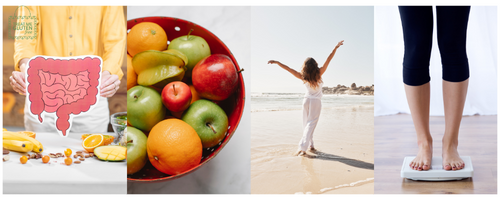
The Gluten-Free Path to Healthy Eating: Why It’s More Than a Trend
Share
In recent years, the gluten-free lifestyle has gained significant attention—not just as a solution for those with medical conditions like celiac disease or gluten intolerance but as a broader movement toward healthier eating. For many people, this shift can feel like a daunting challenge at first, especially if bread, pasta, and other gluten-filled favorites have been staples in their diets. But the truth is, going gluten-free can open the door to a world of wholesome, nutritious foods that promote overall health and well-being.

What is Gluten?
Gluten is a protein found in wheat, barley, and rye. It acts as a binding agent, giving dough its elasticity and helping baked goods hold their shape. For those who can tolerate gluten, it’s harmless, but for others, it can cause a range of health issues.
Individuals with celiac disease experience a severe autoimmune reaction when consuming gluten, leading to damage in the small intestine. This can result in malabsorption of nutrients, chronic fatigue, and other health complications. Others may suffer from non-celiac gluten sensitivity, which can cause symptoms such as bloating, headaches, or brain fog, even without the immune response triggered in celiac disease.
But gluten-free living isn’t just for those with these conditions. Many people are turning to gluten-free diets to explore a cleaner, healthier way of eating.
Myths About Gluten-Free Eating
As popular as it’s become, the gluten-free lifestyle is still surrounded by myths. Let’s debunk a few:
-
“Gluten-Free Means Healthier.”
While gluten-free options can be healthier, this isn’t always true. Some processed gluten-free products are high in sugar or lack essential nutrients. It’s important to read labels carefully and prioritize whole, unprocessed foods. -
“It’s Impossible to Go Gluten-Free.”
While it’s an adjustment, gluten-free living is easier than ever thanks to the growing availability of alternatives. With products like gluten-free flours, breads, and even protein powders, you don’t have to give up your favorite foods. -
“You’ll Lose Weight Automatically.”
Gluten-free doesn’t automatically equal low-calorie or weight-loss friendly. The focus should be on balanced eating, not just eliminating gluten.
Health Benefits of Gluten-Free Eating
While the primary reason to go gluten-free is to address gluten-related health conditions, many people find additional benefits from embracing a gluten-free diet. These include:
- Improved Gut Health: Eliminating gluten can ease digestive discomfort for those with gluten sensitivity or intolerance.
- More Energy: A cleaner diet often leads to fewer energy crashes, especially when it’s rich in whole foods.
- Reduced Inflammation: For some, cutting gluten can alleviate joint pain or other inflammation-related symptoms.
- Mental Clarity: Many people report improved focus and reduced brain fog after going gluten-free.
What Can You Eat on a Gluten-Free Diet?
Going gluten-free doesn’t mean your meals have to be boring or restrictive. In fact, it opens the door to exploring a variety of nutrient-rich, naturally gluten-free foods, such as:
- Fruits and Vegetables: These are always gluten-free and packed with vitamins, minerals, and antioxidants.
- Gluten-Free Grains: Quinoa, brown rice, millet, and amaranth are excellent substitutes for wheat-based grains.
- Lean Proteins: Chicken, fish, eggs, and tofu are gluten-free staples.
- Legumes and Nuts: Beans, lentils, almonds, and walnuts are great sources of protein and fiber.
- Dairy Products: Most plain dairy products, like milk, yogurt, and cheese, are naturally gluten-free (though flavored varieties should be checked for hidden gluten).
For convenience, gluten-free snacks like protein bars and versatile protein powders can help fill nutritional gaps and keep you energized throughout the day.
Tips for Transitioning to Gluten-Free
- Start Simple: Begin by focusing on naturally gluten-free foods before exploring specialty products.
- Read Labels Carefully: Gluten can hide in unexpected places, like sauces, soups, and even candy.
- Experiment in the Kitchen: Try out gluten-free flours like almond or coconut flour for baking or use zucchini noodles in place of pasta.
- Plan Ahead: Dining out can be tricky, so check menus in advance or call ahead to ask about gluten-free options.
- Don’t Be Afraid to Ask for Help: Seek guidance from a dietitian or explore online resources to make your journey smoother.
The Role of Gluten-Free Products
Thanks to the increasing awareness around gluten intolerance, there’s now a wide range of gluten-free products available. Items like protein powders and protein bars have become essential for people living a gluten-free lifestyle, offering convenience without compromising on nutrition.
At [Your Store Name], we’ve curated a selection of premium gluten-free products that make healthy eating easier. From high-protein snacks to meal enhancers, our collection is designed to support your wellness goals while keeping flavor front and center.
Is Gluten-Free Right for You?
Whether you’re living with a medical condition, exploring a new diet, or simply trying to eat cleaner, gluten-free living offers an array of benefits. It’s not about deprivation—it’s about embracing a healthier, more thoughtful approach to food.
Resources to Get You Started
For further reading, check out these helpful articles:
At Foodies Haven, we’re committed to helping you on your gluten-free journey with delicious, nutritious, and innovative products. Discover how good gluten-free living can feel—and taste!
Let’s fuel your healthy lifestyle, one gluten-free bite at a time.